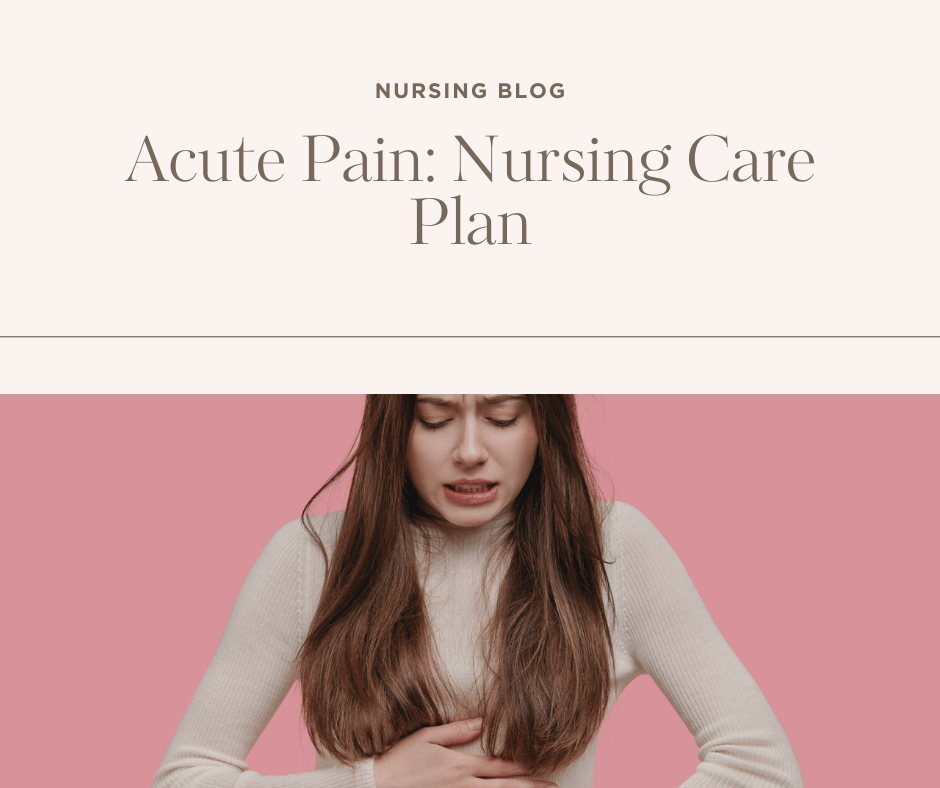Table of Contents
Disclaimer: This is a sample of acute pain nursing care plan and should be adapted to fit the specific needs of each patient. It is important to follow facility protocols and physician’s orders when providing pain management care.
Almost everyone feels pain at some point. Acute pain is a sharp or intense pain that can start suddenly or build up slowly. It might last for a few seconds or even up to six months. If it goes on for more than six months, it’s called chronic pain. Pain is highly subjective, meaning it varies greatly from person to person.
What is Acute Pain?
Acute pain is a sensory and emotional experience linked to actual or potential tissue damage. To fully understand the effects of pain, we need to grasp its pathophysiology. Acute pain happens when peripheral pain receptors, particularly A delta and C sensory nerve fibers, are activated due to tissue damage.
Signs and Symptoms of Acute Pain
What the patient feels:
- Sharp or intense pain
- Throbbing or aching
- Trouble sleeping
- Hard to concentrate
- Feeling restless or anxious
- Difficulty with daily activities
- Feeling dizzy
What the nurse sees:
- Faster pulse
- Higher blood pressure
- Grimacing face
- Protecting the painful area
- Irritability
- Pale skin
Causes and At-Risk Groups
Acute pain can be caused by things like:
- Surgery
- Injuries
- Inflammation
- Infections
- Medical conditions like heart attacks or broken bones
Pain Assessment Tools
To measure pain, nurses can use different tools, such as:
- Brief Pain Inventory
- Wong-Baker Faces Pain Scale
- FLACC Scale
- Visual Analog Scale
- PQRST Pain Assessment
- Numerical Rating Scale
- Indiana Polyclinic Combined Pain Scale
Nursing Diagnoses for Acute Pain
Common nursing diagnoses include:
- Limited movement due to pain
- Anxiety because of pain
- Trouble sleeping because of pain
- Difficulty coping with pain
- Risk of falling due to pain
Goals and Expected Outcomes
Goal: The patient will report a decrease in pain level to a manageable level (e.g., 3/10 or less) on a pain scale within 4 hours of intervention.
Expected Outcomes:
- The patient will verbalize the use of appropriate pain management strategies.
- Vital signs will remain within normal limits for the patient.
- The patient will demonstrate improved comfort and relaxation (e.g., relaxed facial expressions, decreased muscle tension).
- The patient will be able to participate in activities of daily living (ADLs) to the extent possible.
Nursing Interventions for Acute Pain
Dependent:
- Administer Pain Medications: Provide the prescribed pain relief medications.
- Monitor Effectiveness: Check if the medication is working and watch for side effects.
Independent:
- Positioning: Help the patient find comfortable positions to reduce pain.
- Heat/Cold Therapy: Use heat or cold packs based on the pain source.
- Relaxation Techniques: Guide the patient through deep breathing or guided imagery.
- Distraction: Offer diversions like music or conversation to take their mind off the pain.
- Patient Education: Teach the patient about pain management strategies and the proper use of medications.
Collaborative:
- Develop a Pain Management Plan: Work with the doctor to create a personalized acute pain nursing care plan that includes medication and non-drug methods.
- Coordinate Care: Collaborate with other healthcare professionals for comprehensive pain management.
- Monitor Side Effects: While the doctor prescribes medication, monitor for side effects and work with the doctor to manage them.
Non-Drug Methods
Besides medication, methods like visualization exercises, heat or cold packs, and changing positions can help ease pain.
Medication for Pain
When other methods don’t work, medications like pain relievers and anti-inflammatory drugs are used to manage pain.
Evaluation and Documentation
- Continuously Assess Pain Levels: Use a pain scale to check the patient’s pain regularly.
- Evaluate Interventions: See if the pain relief methods are working.
- Document: Record all assessments, interventions, and patient responses in the medical record.
- Modify Care Plan: Adjust the plan based on how the patient responds.
Acute Pain Nursing Care Plan
Impaired Mobility
Nursing Diagnosis: Limited movement due to acute pain
Causes:
- Pain from surgery or injury
- Muscle or joint issues
- Reduced movement due to pain or swelling
Expected Outcomes:
- The patient will report less pain.
- The patient will perform mobility activities better.
- The patient will maintain or improve their range of motion.
Nursing Interventions:
- Administer Pain Meds: Pain management helps improve mobility.
- Assist with Positioning: Proper positioning and use of assistive devices help alleviate pain.
- Encourage Movement: Regular exercises prevent stiffness and improve mobility.
- Provide Education: Teach pain management and relaxation exercises.
- Monitor Progress: Regularly check the patient’s pain and mobility.
Internal Links:
External Links:
Subscribe for More!
Stay updated on the latest tips and strategies for effective nursing care. Join our community of passionate nurses and healthcare professionals dedicated to continuous learning and professional growth. Subscribe today for the latest updates and insights into the world of nursing and healthcare.

Pingback: ASTHMA Nursing Care Plan